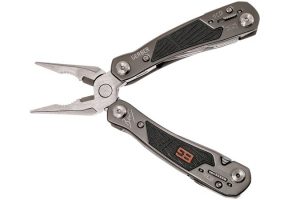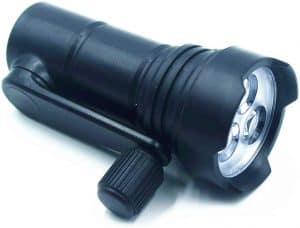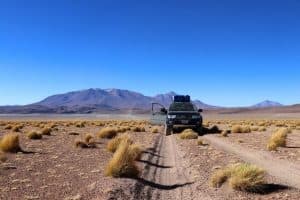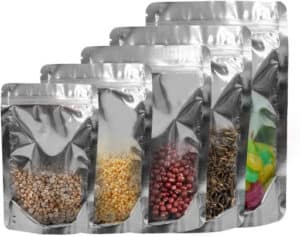Table of Contents
- Be Prepared
- First and Foremost: Food, Water, Misc.
- The Basics: Light
- Another Essential: Radio
- Next: Phone Power
- Multi-Tool
- Other Survival Kits: Wilderness
- Survival Tent
- Fire Starter
- Survival Knife
- Headlamps
- Survival Canteen
- Survival Stove
- Wilderness Survival Kit: Additional Items
- Vehicle Survival Kit
- To Summarize: Complete Kits
Be Prepared
If we’ve learned anything from the recent natural disasters plaguing the world, it’s that worst case scenarios do actually happen. While we have advanced technology to help us predict when hurricanes, tsunamis, blizzards, earthquakes and so forth may strike, even the most accurate forecasts can be wrong. A hurricane can veer off of its projected path. A foot more of snow can fall than expected. Massive flooding can occur. No matter what time of year it is or where exactly you live, you are always vulnerable to an unexpected event, emergency or accident.
Naturally, when dangerous weather is on the way, people head to the stores to stock up on supplies. Unfortunately, when everyone is preparing for an emergency at the same time, store shelves are empty and people are left without critical supplies such as food, water, flashlights and so on. To avoid this perilous situation, it’s important to assemble a survival kit ahead of time. Hopefully, you will never need to use your survival kit. However, it’s important to plan for the worst in order to keep you and your family safe. Of course, there is more than one type of survival kit. There are home survival kits, wilderness survival kits, vehicle survival kits, strictly medical kits, hurricane survival kits and many more.
In this article, the essential items that you should put in your home, wilderness and vehicle survival kits are outlined so that you are not caught unprepared should disaster strike, reducing your stress and increasing your safety.
First and Foremost: Food, Water, Misc.
First, your home survival kit must contain some items that may seem obvious but are important nonetheless.
These miscellaneous items include the following, which, if applicable, should be gathered in quantities that will last for three days, per the Red Cross:
- Non-perishable food (energy bars, nutritious items high in protein). Also, check out emergency food bars; they have a shelf life of five years and can provide three days’ sustenance, foods that do not require cooking or preparation (ready to eat), peanut butter, tuna, cereal, dried fruit, granola, nuts (unsalted), trail mix, canned vegetables and soups, electrolyte-rich drinks, infant formula (if applicable), vitamins
- Comprehensive first aid kit
- Fire extinguisher
- Sleeping bag (one per person)
- Plastic utensils, paper plates, towels, cups
- Bleach (diluted bleach can be used to sanitize items)
- Dust mask
- Evacuation plan, reviewed with the family beforehand
- Prescription medication
- Non-prescription medication (pain relievers, cold medication, etc.)
- Sanitary/hygiene products (wipes, toilet paper, antibacterial gel, dry shampoo)
- Waterproof matches
- Cash
- Towels
- Duct tape
- Copies of your important documents
- Your emergency contacts’ information
- Emergency whistle (to assist rescue teams with locating you)
- Spare clothing
- Blankets (including water-resistant mylar blankets) to prevent hypothermia
- Pet food (if applicable) and pet carrier
- Area maps
- A military-grade compass
Once you have assembled the above-listed items, you have the foundation of your survival kit. Now, we will review some additional essentials that will help to keep you safe.
The Basics: Light
Second, before anything else, you need to be able to see to be able to function. Power outages are one of the most common hazards that occur during emergencies. Millions of power outages occur in the United States every year. While it’s important to have reliable flashlights and plenty of batteries on hand, it’s also key that you have several emergency lanterns. If you should lose power for a week, you need adequate lighting. Today’s emergency lanterns are bright, efficient and long-lasting. LED lanterns get especially high marks as far as battery life goes, and they are generally inexpensive.
Emergency lanterns range in brightness (lumens); some are dim, like nightlights, and others can illuminate an entire room. The greater the lumens, the greater the demand for power. Lanterns with 200-1000 lumens will, therefore, go through batteries faster. It is recommended that you have more than one emergency lantern in your kit, along with plenty of extra batteries.
Additionally, flashlights are also helpful, especially for walking around the house. You may find it easier to navigate through your home while carrying a flashlight while leaving your lanterns in a designated, stationary area. Solar and hand-powered flashlights are available on the market, eliminating the need for batteries. Make sure that the emergency lanterns and flashlights you select are water-resistant and durable.
Today’s emergency flashlights are both efficient and powerful and are surprisingly lightweight. Try using all of your emergency lighting equipment ahead of time so that you know how each item operates. Ease of use is important in a survival situation.
Also, emergency candles are helpful to have. They are slow-burning and can provide up to 36 uninterrupted hours of light. Most are wind and water-resistant. The candles have multiple wicks to allow for maximum burning time. For extra protection from the elements, hurricane candle holders are also available. They are strong, shatter-proof, and reduce the risk of a fire.
Another Essential: Radio
Third, a survival kit should contain a hand, solar or battery-powered NOAA radio. NOAA radios provide forecasts, alarms, alerts and even sirens in the event of imminent danger. While hand-crank powered devices may seem a bit archaic, they do not require batteries, electricity or anything other than the energy you physically supply to operate. Battery-powered radios tend to be more technologically advanced; some even include USB ports for charging other devices.
Importantly, you do not want to be incommunicado during a disaster. Emergency radios are an absolute must-have so that you receive critical updates, information concerning shelters, warming and cooling stations, evacuation orders, weather updates, and other key information.
In fact, there are emergency two-way radios which allow you to stay in constant communication. When all other lines of communication fail, two-way radios are a way to call for help, send SOS messages, and alert others to your whereabouts and welfare. Like advanced walkie-talkies, emergency radios are able to reach a three-mile radius. Some two-way radios can last up to 96 hours on a single charge.
Regardless of which type of emergency radio you choose, be sure that you are able to charge it.
Next: Phone Power
Fourth, in the event you lose power but still have cell phone service, you will need a power source to keep your phone charged. If you have access to a vehicle and a car charger, that is one option. A more convenient alternative is to have an external charger. External chargers can be used to power cell phones, laptops, and tablets. This is another way to receive important emergency updates as well as stay in touch with others. Most external chargers for cell phones need to be charged ahead of time via a USB connection that plugs into an outlet. However, there are battery and solar powered chargers as well. Having an external charger can mean the difference between having a line of communication and being essentially isolated.
Multi-Tool
 Fifth, your survival kit should contain a multi-tool that can do it all. A multi-tool should be able to serve as a knife, a folding saw, tweezers, scissors, a file, a wrench, a screwdriver, and more. Most multi-tools have 10 or more features for different survival-related purposes. Most emergency multi-tools have upwards of 30 different components, all of which fold out to serve a different purpose. The tool should help with first-aid related tasks, to start a fire, to open cans, to perform repairs, and more. A good multi-tool eliminates the need to keep an entire toolbox on hand. Today’s multi-tools are lightweight and compact, with comfortable grips.
Fifth, your survival kit should contain a multi-tool that can do it all. A multi-tool should be able to serve as a knife, a folding saw, tweezers, scissors, a file, a wrench, a screwdriver, and more. Most multi-tools have 10 or more features for different survival-related purposes. Most emergency multi-tools have upwards of 30 different components, all of which fold out to serve a different purpose. The tool should help with first-aid related tasks, to start a fire, to open cans, to perform repairs, and more. A good multi-tool eliminates the need to keep an entire toolbox on hand. Today’s multi-tools are lightweight and compact, with comfortable grips.
Other Survival Kits: Wilderness
Of course, in addition to home survival kits, there are other kinds of survival kits that you may need to prepare. A common type is the wilderness survival kit. In the event you are stranded in the woods, you should have everything you need to survive available in your portable kit. Like a home survival kit, your wilderness survival kit should include a whistle, a compass, a hand-crank radio or two-way radio, flashlights, a multi-tool, a first aid kit, water, and non-perishable food as discussed in more detail above. However, there are additional items that are specifically designed for survival in the wilderness.
Survival Tent
Unquestionably, a survival tent is one of the most important items to include in your wilderness survival kit. Survival tents are lightweight, compact, quick and easy to assemble, and convenient. A tent will provide the shelter you need to survive, especially in cold temperatures. The tent you select depends on how many people you need to accommodate, the terrain and the climate. In cold temperatures, tents insulated with mylar do a great job of keeping heat sealed inside the tent. The tent should be stable and able to withstand harsh conditions, including extreme temperatures, wind, rain, and snow.
For convenience, select a tent that comes included with all of the component parts, such as stakes and poles. Be sure to take the number of people who will be taking shelter inside the tent into consideration, as tents are sold in various sizes. Ensure that the tent is spacious enough to comfortably fit everyone taking shelter inside it as well as their gear. If you are going to be in a warm climate, consider a tent with a mesh liner to keep insects out.
Fire Starter
Without a doubt, fire starters are another important part of a wilderness survival kit. A good rule of thumb is to always have at least three different methods of starting a fire at your disposal, since there is always a chance that a method can fail. For obvious reasons, the ability to start a fire in the wilderness is extremely important. A fire can provide warmth for your shelter, cook food, boil water, and as a signal to aid rescue workers in locating you.
An obvious method of starting a fire is by using a match. Always carry water-resistant matches in your kit in case they get wet. Another option is a Ferro rod, also known as the flint and steel method, which can be used to strike and spark a fire. Ferro rods can also combust when combined with magnesium. Additionally, fire pistons can be carried. These devices operate using charcloth and compressed gas. Others use flint and tinder to create a combustion reaction. Water and wind-proof lighters are also types of portable fire starters. Some Ferro-rod fire starters are small enough to be carried in your pocket or worn around your neck.
Survival Knife
No wilderness survival kit would ever be complete without the proper knife. A survival knife is different from a multi-tool. Multi-tools should also be carried in your kit in addition to the survival knife. The knife must be tough, and able to withstand serious use, cold temperatures, exposure to moisture and abrasions. A bowie knife is an good example.
Your knife may be used for cutting and chopping food, protection, and hunting. The knife will help you with everything from preparing a fire to skinning an animal if need be. As such, the knives, including the actual blades, are considerably larger than the size of a pocket knife that you would carry around with you. The blades of most survival knives are upwards of four inches but you can also find ones great you can wear around your neck.
The knife should have a no-slip grip so that you can still handle it safely if your hands are sweaty. The grip should also be comfortable. If you choose a folding knife as opposed to a fixed blade, it should be easy to open and close. If it’s a fixed blade knife, make sure it comes with a durable sheath. For obvious reasons, folding knives are more portable than fixed-blade options.
Some survival knives have extra features that make them even more useful. For example, some knives have built-in fire-starting components, such as flint or magnesium in the hilt. Typically, these knives have hollow handles.
Review the knife carefully. Consider the hardness of the steel, corrosion resistance, sharpness/edge retention, and wear resistance. The shape of the blade is also important in determining how the knife will be used. Most survival knives have blades that are four different shapes:
- Straight-back – efficient for chopping and splitting wood; great for fire preparation
- Drop-point – intended for carving and cutting, among other tasks
- Tanto – good for stabbing and self-defense
- Clip – good for skinning, stabbing, and self-defense; most bowie knives have clip blades
Another consideration is the knife’s tang, or how far the blade extends into the handle of the knife. Many outdoors enthusiasts prefer full tang knives, because they allow you to wield the knife with the most power. Since so many outdoor survival tasks require strength and power, full tang may be the best way to go, with the least amount of risk that the blade will break off.
When selecting a survival knife, a lot of the process boils down to personal preference. It is helpful to visit a sporting goods/outdoor equipment store to try out the different grips and see which style is most comfortable for you.
Headlamps
Additionally, another key component of your wilderness survival kit is a set of headlamps. Headlamps can be invaluable in an emergency as they allow you to see without tying up your hands. Also, headlamps illuminate the area you are looking at. No light (or energy) is wasted. Headlamps are typically powered by USB or batteries. Many headlamps are rechargeable. Check out how long the headlamps will last on a single charge, as this is paramount. Another consideration is how many lumen the headlamps are. Select a set of headlamps that are waterproof.
A nice feature that some headlamps have is a dimmer. The dimmer allows you to adjust the brightness output. Headlamps are available with white, green and red filters. A green filter will give you the best night vision. White headlamps provide the strongest overall brightness.
Survival Canteen
Clearly, staying hydrated is of the utmost importance. A survival canteen is another essential item to be added to your survival kit. Ideally, your canteen should be made of titanium or stainless steel, not plastic as it is not durable enough. Titanium and stainless steel canteens also last longer than plastic options. Plus, water from plastic canteens can often have an unpleasant taste. Like a regular water bottle, your canteen should be BPA-free.
Select a canteen that is non-insulated. Insulated canteens cannot be used to boil water. The ability to boil and purify water can mean the difference between staying hydrated and winding up in a dangerous situation. The canteen should be small enough to be easily transported, yet large enough to fit a good supply of water. Look for a canteen with a 30-60 ounce interior. The canteen should have a wide mouth and be easily refilled. The canteen should seal securely to reduce the risk of leaking.
An added feature that increases a canteen’s convenience is a strap so that the canteen can be easily carried.
Survival Stove
Another item to include in your wilderness survival kit is a survival stove. A stove will allow you to do everything from cooking food to boiling water, killing bacteria and making it safe to drink. One drawback to portable stoves that you should consider is the fact that most are fueled by propane. That said, the stoves are still convenient, portable and surprisingly lightweight, on top of being extremely useful. In fact, some stoves are foldable and can easily fit inside a survival backpack. Different types include wood stoves, alcohol stoves, canister stoves, solid fuel stoves, and liquid fuel stoves.
The type of stove you choose should depend largely on the size of the pots you will be cooking with. The larger the pot, the larger the base of the stove should be. If you cook with small pots, a canister stove is your best option. For larger pots, a wood or fuel stove with a larger base will provide greater stability.
Wood stoves tend to be easier to use, and they are among the most lightweight and compact options. Additionally, wood stoves are energy efficient and do not require any fuel. However, cooking food with a wood stove can take longer than it would with other stoves. Also, wood stoves are not suitable for extremely cold temperatures.
Wilderness Survival Kit: Additional Items
In addition to the essentials listed above, you may want to invest in the following to complete your wilderness survival kit:
-
- Splitting maul
- Bow or crossbow for hunting
- Insulated gloves
- Survival watch
- Personalized bug out bag
-
- Shovel
- Mini water filter (can remove 99.99% of bacteria and other impurities)
- Survival bracelet (many bracelets include snare wire, waxed jute, and fishing line)
- Tinder box
- Tactical flashlight (can also be used for self-defense)
- Blast whistle (can be heard distances over a mile away)
- Blade sharpener
- Pocket fishing pole, tackle
- Solar charger
- Utility belt
- Paracord
- Insulated poncho
Vehicle Survival Kit
It is also important to gather together a vehicle survival kit. Your vehicle survival kit should contain some of the same items as your home and wilderness kits, such as flashlights, emergency food, purified water, batteries, and a first-aid kit.
Your vehicle survival kit should also include:
- Space blanket – a metal-coated blanket that provides chemical heat for extra warmth
- Flares
- Whistle
- USB-chargeable flashlights
- Windshield hammer – used to break a car’s windshield or windows if the vehicle should become submerged; can be carried on a keychain
- Hand-crank radio and cellphone charger
- Seatbelt cutter
- Extra clothing
To Summarize: Complete Kits
In conclusion, while no one wants to live in constant fear, natural disasters, outdoor emergencies, and accidents are events for which we need to prepare. Rather than waiting until the last minute to gather supplies, it is much more sensible to put together a survival kit ahead of time. By collecting the essential items outlined above, we can ensure our safety and well-being, even in disastrous weather conditions; even if we’re lost in the woods, and even if we have an emergency in a vehicle. Hopefully, you will be fortunate enough to never need to use your survival kit. However, in the event of an emergency, you will have the peace of mind of knowing that no matter what happens, you will be ready.
Sources
- USNews.com, Natural Disasters
- CNN.com, Some Walmart Shoppers in Florida are Finding Empty Shelves
- EnergyProfessionals.com, Power Outages on the Rise in the US
- EmergencyPlanGuide.org, Best Emergency Lanterns for Power Outage
- The New York Times, How to Pack an Emergency Kit for Any Disaster
- Business Insider, 15 Home Emergency Kit Products Everyone Should Have
- NOAA, National Weather Service
- American Red Cross, What do You Need in a Survival Kit
- Alderleaf Wilderness College, Survival Fire Starters
- Popular Mechanics, The Ultimate Survival Preparedness Kit for Your Car





